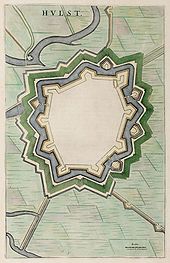Hulst
Hulst | |
|---|---|
City and Municipality | |
 Basilica of Hulst in 2006 | |
 | |
| Coordinates: 51°17′N 4°3′E / 51.283°N 4.050°E | |
| Country | Netherlands |
| Province | Zeeland |
| Government | |
| • Body | Municipal council |
| • Mayor | Jan-Frans Mulder (CDA) |
| Area | |
• Total | 251.82 km2 (97.23 sq mi) |
| • Land | 201.71 km2 (77.88 sq mi) |
| • Water | 50.11 km2 (19.35 sq mi) |
| Elevation | 3 m (10 ft) |
| Population (January 2021)[4] | |
• Total | 27,575 |
| • Density | 137/km2 (350/sq mi) |
| Demonym | Hulstenaar |
| Time zone | UTC+1 (CET) |
| • Summer (DST) | UTC+2 (CEST) |
| Postcode | 4560–4569, 4580–4589 |
| Area code | 0114 |
| Website | www |
Hulst (Template:IPA-nl) is a municipality and city in southwestern Netherlands in the east of Zeelandic Flanders.
History

Hulst received city rights in the 12th century.
Hulst was captured from the Spanish in 1591 by Maurice of Orange but was recaptured by Archduke Albert in 1596.
In 1645, the Siege of Hulst (to control the left bank of the Schelde river) occurred. It was led by Prince of Orange Frederick Henry, during the Eighty Years' War (1568–1648) with Spain.
A further siege took place in 1702, where General Menno van Coehoorn defended the town successfully for the Dutch and in 1747 when it was taken by the French after incompetent defence by Lt General Pieter de la Rocque.[5]
In the seventeenth century, a star fort was constructed.[6] The fortifications, constructed during that time, are historic examples of Dutch fortress architecture.
The name Hulst (Holly in English) would appear to come from the shape of the battlements. Holly is depicted growing around the towns crest.
Geography

Hulst is located at 51°17′N 4°3′E / 51.283°N 4.050°E in the south of the province of Zeeland in the southwest of the Netherlands. It is situated in the east of the region Zeelandic Flanders, which is connected by land only to Belgium, on the Dutch-Belgian border.
Hulst is neighbouring the municipalities of Terneuzen in the west, Stekene (Belgium) and Sint-Gillis-Waas (B) in the south, Beveren (B) in the east, and Reimerswaal in the north. The river Western Scheldt separates the land of Reimerswaal and Hulst.
The Drowned Land of Saeftinghe (Verdronken land van Saeftinghe) is a natural reserve in the north of the municipality. Its name refers to the Saeftinghe legend.
The population centers in the municipality are:
|
Government
The mayor of Hulst is Jan-Frans Mulder of the Christian Democratic Appeal.
International relations
Hulst is twinned with Michelstadt, Germany.
Gallery
-
View of Hulst painted in 1628 by Cornelis de Vos
-
Gate (de Gentse Poort)
-
View to a street: de Gentsestraat
-
Historical houses
-
Monument on the defensive rampart of Hulst
-
Artwork by Kris Ferket
-
The museum De Vier Ambachten, former refugium of the Abbey Our Lady Ten Duinen
References
- ^ "College van burgemeester en wethouders" (in Dutch). Gemeente Hulst. Retrieved 11 December 2013.
{{cite web}}: Unknown parameter|trans_title=ignored (|trans-title=suggested) (help) - ^ "Kerncijfers wijken en buurten 2020" [Key figures for neighbourhoods 2020]. StatLine (in Dutch). CBS. 24 July 2020. Retrieved 19 September 2020.
- ^ "Postcodetool for 4561EA". Actueel Hoogtebestand Nederland (in Dutch). Het Waterschapshuis. Archived from the original on 21 September 2013. Retrieved 11 December 2013.
{{cite web}}: Cite has empty unknown parameter:|trans_title=(help); Unknown parameter|deadurl=ignored (|url-status=suggested) (help) - ^ "Bevolkingsontwikkeling; regio per maand" [Population growth; regions per month]. CBS Statline (in Dutch). CBS. 1 January 2021. Retrieved 2 January 2022.
- ^ "Further". Lowensteyn.com. Retrieved 2012-03-12.
- ^ Template:Nl icon Geschiedenis van Hulst. Hulst Vestingstad
External links
- Official website (in Dutch)










